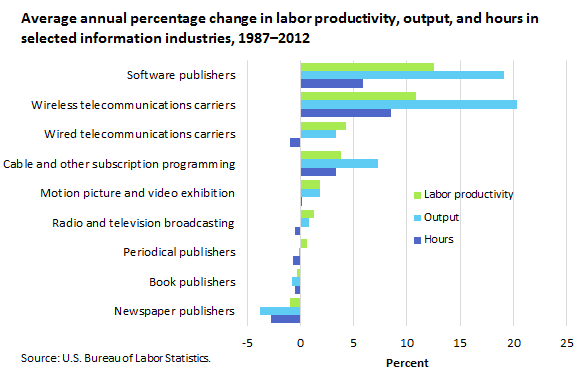An official website of the United States government
 United States Department of Labor
United States Department of Labor
The information industry has transformed markedly over the last quarter century. The number of people using computers, the Internet, mobile phones, and other electronic devices at work, school, home, and elsewhere has grown tremendously. This transformation is apparent in BLS measures of productivity. Labor productivity in the software publishing industry grew at an average rate of 12.5 percent per year from 1987 to 2012. At the other end of the spectrum, labor productivity among newspaper publishers declined at an average annual rate of 1.0 percent over the same period.

| Industry | Labor productivity | Output | Hours |
|---|---|---|---|
Software publishers | 12.5 | 19.1 | 5.9 |
Wireless telecommunications carriers | 10.9 | 20.3 | 8.5 |
Wired telecommunications carriers | 4.3 | 3.3 | -1.0 |
Cable and other subscription programming | 3.8 | 7.3 | 3.3 |
Motion picture and video exhibition | 1.8 | 1.8 | 0.1 |
Radio and television broadcasting | 1.3 | 0.8 | -0.5 |
Periodical publishers | 0.6 | -0.1 | -0.7 |
Book publishers | -0.3 | -0.8 | -0.5 |
Newspaper publishers | -1.0 | -3.8 | -2.8 |
Labor productivity is defined as an industry’s total output per hour worked. The output of software publishers grew at an average annual rate of 19.1 percent from 1987 to 2012, while total hours worked in the industry grew at a rate of 5.9 percent annually. The large difference between the growth in output and the growth in hours resulted in rapid productivity growth in the industry.
The newspaper industry, in contrast, experienced declining output at a rate of -3.8 percent annually and declining hours at a rate of -2.8 percent annually, resulting in the fall in productivity over the 1987–2012 period.
Wireless telecommunications carriers experienced productivity growth of 10.9 percent annually from 1987 to 2012, a result of output growing 20.3 percent per year and hours growing 8.5 percent per year.
These data are from the Labor Productivity and Costs program. To learn more, see “Productivity and Costs by Industry: Selected Service-Providing and Mining Industries—2012,” news release USDL‑14‑0872 (HTML) (PDF).
Bureau of Labor Statistics, U.S. Department of Labor, The Economics Daily, Productivity in the information industry, 1987–2012 at https://www.bls.gov/opub/ted/2014/ted_20140527.htm (visited May 19, 2024).

